For some time we have been considering a migration from a DSL FTTC service, (Plusnet) which, at best, connected at 74 Mbps down and around 15 up.
Real world, speed tests indicated a throughput of around 50Mbps down and 10 up.
The DSL service was rock solid, bandwidth limited – particularly the upload as i self host a few things.
No FTTP products were available here when we switched to Plusnet last summer.
A few weeks ago, some roads were closed in the area for a few days as some fibre works were carried out. I knew some rollout was happening nearby but nothing to suggest it related to our address.
So i was quite surprised a few days later to get a knock at the door from a Virgin sales rep. Ordinarily, i don’t entertain salespeople at the door but this was of interest.
In the end, we checked our termination fees with Plusnet, found them “acceptable” and placed an order.
Installation
We had our installation originally booked for Sat 5th April and the day after the order was placed, VM contractors arrived to pull in the fibre to our property.
This was minimal work as they have an agreement with Openreach to use their ducts to our properties.
Within 20 mins they were gone and we had a new, grey, optibox installed on the wall, right next to where the BT connection enters the house.
This left me with a question – Would they route the “internal” connection to where i wanted? This required hooking up the omnibox to the internal run, routing it externally around our home and then in through an upstairs wall. As it turns out, this was no problem at all, the installer did exactly what i wanted them to, allowing me to plug the router straight into my switch.
We received a message a day or two later offering us an earlier appointment than that scheduled, if we preferred. For me, it was more convenient to bring it forward so the installation was carried out this Monday, 31st March.
The installer arrived, had a chat about requirements and did most of the outside work, popped in to drill a hole and mount the internal box on the wall, plugging in the router at the same time.
She then popped out, finalised the external work and all was done and dusted.
Finally, I connected the hub to my switch using one of the gigabit ports and carried out a speed test (more on this shortly). All being well, the installation was complete.
The Hub5x
Virgin Media issue a Hub 5x to FTTP customers at present.
Appearance-wise, not really an issue for me, these are best out of sight and mind, in my opinion. They are functional devices and you want them to blend in, as much as possible. That said, they’ve made it look ok with it’s dark colour and speaker-esque covering on the front.
The fibre is connected from the internal splitter box directly to the router itself, it offers WiFi 6 and several network ports including one 10G port and three 1G ports.
There are also a couple of telephone sockets for an IP service but i’ve not explored that so cannot comment.
I had a number of queries about the capabilities of this device from a network management standpoint. These were incredibly difficult to answer ahead of getting my hands on the device as there is no detailed documentation available online – or if there is, i couldn’t find it.
Just in case anyone else has any queries, here are the things you can configure on this device as at 3rd April 2025:
Wifi
- Enable/Disable 2.4Ghz and 5Ghz networks.
- Specify channels for both if required.
- Change channel width (smart wifi needs to be disabled) for 2.4Ghz to 20/40Mhz (from 20Mhz). 5Ghz has more bandwidths available up to 160Mhz/
- Enable/Disable “Guest Network” with a separate SSID and password. You can, as always, hide the SSID if you wish.
- Specify the security type for wifi connections up to WPA3-SAE.
- Enable/Disable the WPS button.
Firewall
- Pretty standard firewall settings for a ISP router. Note: Whilst there are various settings for IPv6 on this router, IPv6 is not supported on the Virgin Media network at present.
MAC Filtering
- Fairly basic ability to restrict MAC addresses from the internet. I guess in some cases, if you have kids that won’t get off the net when they should be doing other things, you can restrict access.
- It allows you to fully block access or specify times.
- The downside to this setup is the difficulty in identifying the right address where the device has not broadcast its hostname. As you will see, “Device Name” shows as unknown (not the fault of the router) but it only shows MAC address and what it is connected to.
- With many devices on the network you do need to go armed with the MAC to identify the right device. This becomes a bit redundant if the device issues a random MAC each time (again, not the fault of the router).
- Note: This information can be found with IP address on the Connected Devices info screen.
- Anyway, i found this useful for limiting some virtual machines access to the Net which do not require an internet connection.
IP and Port Filtering
- Not something I use, so will just provide a couple of example screenshots below.

Port Forwarding
- Fairly standard options, found no issues with this either with manually created rules and those added by UPnP.
Port Triggering
- Again, not something I use here but for anyone who is interested, here is a rule config screen.

DMZ
- Basic DMZ setup – Enabled/Disabled and the IP address for the DMZ.
DHCP Server
- Fairly standard options for DHCP, does not allow you to change the subnet which, from recent experience, the Plusnet Hub 2 does. That said, we run our own DHCP server so this is disabled for us.

UPnP
- Enable or disable.
Tools
- Usual network tools to allow a ping or traceroute from the router. Can also specify MTU size if required (defaults to 1500).
- Includes some high level router stats and very basic config and network log.
LED Light
- The Hub 5x has a small blueish-white light on the front, this option allows it to “alert” you by “brightening” if it needs your attention. This can be enabled or disabled and the light intensity can be adjusted.
- This is currently switched on but i’ve not yet noticed it brightening for any reason but then, we’ve had no issues so it wouldn’t need to.
- Guess this function is useful if the light is a distraction in a darkened room.
Change Password
- Allows users to change the default password for the router. There is no username.
- The default password can be found on a sticker on the bottom of the router.
Reload and Reboot
- Standard features to backup and restore router config, restore to factory defaults and to reboot the hub.
Info
- A few more details about the router and connection.
Results
Moving from a <100Mbps connection to a gigabit connection is a huge jump in bandwidth – roughly 15x the download bandwidth and with its 100Mbps upload speed, we increase our upload by around 10x.
So the first question – Is the bandwidth we are promised delivered?
Before we get into the detail, it is worth noting that the Virgin Media Gig1 product comes with 1,130Mbps download speed but, on a gigabit network the theoretical maximum throughput is 1,000Mbps – so there’s 130Mbps (nearly twice the speed of our DSL connection) that we cannot make use of without upgrading our network to 2.5G or 10G – which we have no desire to do.
Ultimately, that means we cannot obtain more than 1000Mbps on any speedtest from our wired network so it is only fair to evaluate the throughput on this basis, not the 1,130 line speed.
Ethernet – Before
- A typical speed test on our DSL line carried out on 30th March 2025.
- This shows a download speed of 53.63Mbps and an upload of 9.58Mbps.
- Idle Ping was 195ms.
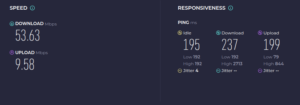
Ethernet – After
- Speed-test taken about 30 mins after installation.
- This shows a download speed of 935.34Mbps and an upload of 105.35Mbps.
- Idle Ping was 12.
Ethernet – Comparison
- Gig1 reached 93.5% of the theoretical maximum on our wired network. Internally, i’ve never seen 1,000Mbps achieved so i think it’s fair to conclude that gig1 maxes out our network.
- 935.34Mbps is 17.4x faster than our previous download speed.
- 105.35Mbps is 11x faster than our previous download speed.
- We saw a marked reduction in latency (ping) from 195 down to 12.
Wifi – Before
- A typical speed test on our DSL line, over 5Ghz wifi carried out on 30th March 2025.
- Both before and after were carried out on the same Samsung S23 FE.
- This shows a download speed of 50.7Mbps and an upload of 12.3Mbps.
- Idle Ping was 20ms.
Wifi – After
- Speed-test taken 3rd April 2025 a few feet from the router.
- This shows a download speed of 925Mbps and an upload of 110Mbps.
- Idle Ping was 12.

Wifi – Comparison
- Gig reached 93.5% of the theoretical maximum on our wifi.
- 925Mbps is 18.2x faster than our previous download speed.
- 110Mbps is 8.9x faster than our previous download speed.
- Ping is lower at 16 from 20. But barely changed in this scenario (think i need to review that as it seems odd the earlier speed test had such a low ping – will see if i can find another speed test to compare/revise).
Cost/Benefit
I guess the next question, is there enough of a benefit in moving to a gigabit internet connection from DSL?
Lets start with cost. Our previous package with Plusnet was costing £24.99 per month.
Our new package with Virgin Media is £36.99, an increase of £12 (+48%). We could have elected to have symmetric upload speed for an extra £6 (maybe £7) per month. We have not taken up this option – even though it is cheap, I cannot see a major benefit.
So overall, on cost, we are paying a bit more.
With an increase in download speed of 1,644%, this massively outstrips the % increase of the cost, so i think on a cost basis, this is justified.
But what benefits does it bring to justify the cost?
For general users:
- Internet browsing on any device is just snappier – pages load instantly, where before there was a slight pause.
- Streaming video services also load instantly rather than the slightly irritating delay we used to get.
- No issues with pausing or resuming a video from pause – youtube used to be fickle for this, we’d find it would resume play but then buffer as the stream hadn’t fully caught up to the play speed.
- Multiple users can do more, faster than they did before. We use a variety of streaming services, WFH, operate tablets, smart TV’s (or firesticks), phones and so on. Everyone in the household has a way better wifi signal strength and throughput – even the older devices. It is unlikely any of us will fill up the entire upload and download bandwidth for very long, if at all.
- As the router includes Wifi6, this is a noticeable upgrade to our wifi throughput, even on the local network.
Overall, for a regular family, I think this is beneficial although not essential. Most of these tasks can be carried out quite happily, with perhaps a little compromise required, on slower connections.
That said, fibre is inevitable for most internet connections as time goes on, it is well future-proofed for much higher bandwidth applications that emerge in years to come – upgrades usually just require changes at both ends of the connection.
I am aware of other ISP’s offering such services for a lower price. They haven’t reached us yet, but it is possible that many users will be able to upgrade to fibre for the same (or roughly the same) price as they pay now.
In an era of never-ending inflation and the effects of earlier inflation, It is good to see that, as a rule, broadband connections are not excessively expensive (note to self: ignores crazy prices for Gig2 from VM).
More Specialist Users:
- For context, we run our own DNS and DHCP (Pihole), a proxmox server running various containers and VM’s (including the one this blog is hosted on).
- We run an nginx reverse proxy managing incoming traffic for our domain.
- We also run a VPN server so we can connect to local systems when not connected directly to the network.
- I run an ADSB flight tracking system and various other systems – for instance, a DMR Hotspot which is a digital amateur radio “mini repeater” (for want of a better description).
- Prior to migrating to Virgin, I also ran a mail server on my local network.
Ultimately, this means, we are running a variety of systems that many households would not and require reasonable upload speed to serve these services externally. We would benefit from a static IP and the ability to set rDNS.
Ultimately, a more sophisticated user will find ways to make everything work as they want. To that end, i have pointed my VPN at a subdomain which is updated with ddclient whenever the dynamic WAN IP changes (it hasn’t as yet).
We are unable to set the DNS servers at router level, this is a minor issue overcame by running our own DHCP server (which we had anyway) and by manually configuring DNS on systems running a static IP.
Everything else pretty much works as it did before. I did migrate my mail server to a hosted solution ahead of install and think i may stick with this arrangement going forwards.
I think it is a shame that the router does not allow us to specify the LAN subnet, giving us more flexibility than a single /24. Some people recommend using the router in modem mode, and adding your own router to control the network. There are reported issues with modem mode and an additional cost for extra hardware which will take up yet another power supply. Honestly, i’d rather not.
Where this broadband comes into its own for this use case is:
- Downloading ISO’s and regular updates is now lightning quick. A test download of a 2Gb file from thinkbroadband took nine mins on our DSL connection, less than 30 seconds on the new connection.
- The increased upload makes hosting services more practical, allowing faster page loads for visitors to the various services we have running.
- Latency is way down, improving the connectivity of our DMR hotspot.
- Other users using bandwidth intensive services no longer have a detrimental impact on download speeds or other activities.
Conclusion
Given this upgrade has added £12 to our monthly bill, is it worth it? If you’re expecting pages to load before you’ve clicked the link, perhaps not! What i mean is, there is only so much a fast connection can do to improve general browsing.
DSL is pretty quick on this, but fibre is undoubtedly better. But there is a limitation as to how much page loading can be sped up – this is partly due to the connection and partly down to hardware and software choices of the user.
That said, for a snappier connection alone, i think the cost is worth it. For the added benefits of faster downloads and uploads, there is no question.
Overall, I think the Gig1 update from DSL is absolutely worth the minor price differential. I do not say the same of the Gig2 product at over £80 per month. I think the cost is too high and cannot see many environments which, at present, need that kind of capacity.
It may well be, in years to come, some killer apps suddenly require huge throughput but even multiple streams of 4K video are unlikely to saturate the Gig1 capacity – and generally 4K streaming is one of the more bandwidth heavy applications on the internet.
I think Virgin Media would do well to enhance the capabilities of their routers on these products – they don’t need to do much but a few more LAN options would be helpful. I would also urge them to publish more detailed documentation on these devices.
Having been online since the mid 90s, starting at 33.3k, being an early adopter of Virgin Media (then Telewest) Blueyonder at 512k, moving on through the DSL products as they emerged, I’ve been around internet connectivity for many years.
There have been step-changes in that period –
- Dialup used to charge per minute – both to the landline provider and the ISP, as well as additional monthly fees for each. Bandwidth was 34,000x slower than today.
- Dialup was still slow but moved to a freephone (0800) dialup arrangement, making it cheaper to connect.
- Telewest were the first to offer “broadband” where i lived, 512k connection for about £50 a month (equivalent to £92 in 2025). 2,200x slower than today.
- Various types of DSL and cable came over the years with our most recent (and last) DSL connection being <100Mbps.
The point is, since early Cable and DSL broadband services emerged, change from my perspective has been incremental, based on enhancing existing technologies rather than deploying (more widely), revolutionary technologies such as fibre.
I understand many larger towns and cities have various alternative providers (“altnets”) and have for some time. But this is now reaching the smaller towns and cities, deployment is ramping up and there seems to be plenty of competition given the distinct infrastructure being rolled out.
As the old PSTN network is switched off for voice and more homes and businesses are migrated to fibre, it doesn’t seem a stretch to see the old copper networks – both BT and Virgin Media (and other smaller providers), being left to wither and fade away.
I am sure there are many issues to be dealt with along the way, so that more rural areas, or those with particular needs/reliance on existing networks, are not left behind, but the future is fibre and well worth the upgrade.

Leave a Reply